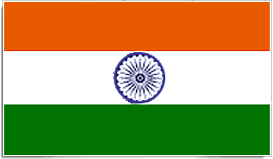Flag Code of India, 2002

The Indian National Flag represents the hopes and aspirations of the people of India. It is the symbol of our national pride. Over the last five decades, several people including members of armed forces have ungrudgingly laid down their lives to keep the tricolour flying in its full glory.
The significance of the colours and the chakra in the National Flag was amply described by Dr. S. Radhakrishnan in the Constituent Assembly which unanimously adopted the National Flag. Dr. S. Radhakrishnan explained—“Bhagwa or the saffron colour denotes renunciation of disinterestedness. Our leaders must be in different to material gains and dedicate themselves to their work. The white in the centre is light, the path of truth to guide our conduct. The green shows our relation to soil, our relation to the plant life here on which all other life depends. The Ashoka Wheel in the center of the white is the wheel of the law of dharma. Truth or satya, dharma or virtue ought to be the controlling principles of those who work under this flag. Again, the wheel denotes motion. There is death in stagnation. There is life in movement. India should no more resist change, it must move and go forward. The wheel represents the dynamism of a peaceful change.”
There is universal affection and respect for, and loyalty to, the National Flag. Yet, a perceptible lack of awareness is often noticed, not only amongst people but also in the organisations/agencies of the government, in regard to laws, practices and conventions that apply to the display of the National Flag. Apart from non-statutory instructions issued by the Government from time to time, display of the National Flag is governed by the provisions of the Emblems and Names (Prevention of Improper Use) Act, 1950 (No.12 of 1950) and the Prevention of Insults to National Honour Act, 1971 (No. 69 of 1971). Flag Code of India, 2002 is an attempt to bring together all such laws, conventions, practices and instructions for the guidance and benefit of all concerned.
For the sake of convenience, Flag Code of India, 2002, has been divided into three parts. Part I of the Code contains general description of the National Flag. Part II of the Code is devoted to the display of the National Flag by members of public, private organizations, educational institutions, etc. Part III of the Code relates to display of the National Flag by Central and State governments and their organisations and agencies.
The significance of the colours and the chakra in the National Flag was amply described by Dr. S. Radhakrishnan in the Constituent Assembly which unanimously adopted the National Flag. Dr. S. Radhakrishnan explained—“Bhagwa or the saffron colour denotes renunciation of disinterestedness. Our leaders must be in different to material gains and dedicate themselves to their work. The white in the centre is light, the path of truth to guide our conduct. The green shows our relation to soil, our relation to the plant life here on which all other life depends. The Ashoka Wheel in the center of the white is the wheel of the law of dharma. Truth or satya, dharma or virtue ought to be the controlling principles of those who work under this flag. Again, the wheel denotes motion. There is death in stagnation. There is life in movement. India should no more resist change, it must move and go forward. The wheel represents the dynamism of a peaceful change.”
There is universal affection and respect for, and loyalty to, the National Flag. Yet, a perceptible lack of awareness is often noticed, not only amongst people but also in the organisations/agencies of the government, in regard to laws, practices and conventions that apply to the display of the National Flag. Apart from non-statutory instructions issued by the Government from time to time, display of the National Flag is governed by the provisions of the Emblems and Names (Prevention of Improper Use) Act, 1950 (No.12 of 1950) and the Prevention of Insults to National Honour Act, 1971 (No. 69 of 1971). Flag Code of India, 2002 is an attempt to bring together all such laws, conventions, practices and instructions for the guidance and benefit of all concerned.
For the sake of convenience, Flag Code of India, 2002, has been divided into three parts. Part I of the Code contains general description of the National Flag. Part II of the Code is devoted to the display of the National Flag by members of public, private organizations, educational institutions, etc. Part III of the Code relates to display of the National Flag by Central and State governments and their organisations and agencies.
Flag Code of India, 2002, takes effect from January 26, 2002 and supersedes the ‘Flag Code – India’ as it existed.

